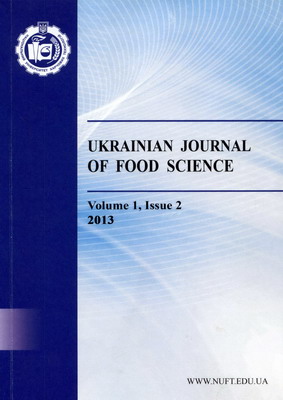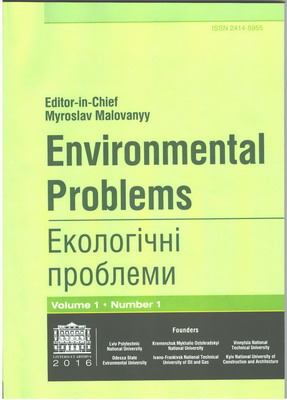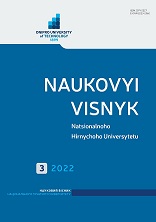 Книжкові видання та компакт-диски  Журнали та продовжувані видання  Автореферати дисертацій  Реферативна база даних  Наукова періодика України  Тематичний навігатор  Авторитетний файл імен осіб
 |
Для швидкої роботи та реалізації всіх функціональних можливостей пошукової системи використовуйте браузер
"Mozilla Firefox" |
|
|
Повнотекстовий пошук
Пошуковий запит: (<.>A=Volchyn I$<.>) |
Загальна кількість знайдених документів : 5
Представлено документи з 1 до 5
|
| 1. |

Volchyn I.
Engineering method for calculating the parameters of flue gas parameters of coal-fired thermal power plants based on solid fuel characteristics [Електронний ресурс] / I. Volchyn, L. Haponych // Ukrainian journal of food science. - 2016. - Vol. 4, Iss. 2. - С. 327-338. - Режим доступу: http://nbuv.gov.ua/UJRN/ujfs_2016_4_2_14
| | 2. |

Volchyn I.
Emissions of sulfur dioxide and dust at coal power plants of Ukraine [Електронний ресурс] / I. Volchyn, L. Haponych, V. Bizek // Environmental problems. - 2021. - Vol. 6, Num. 3. - С. 145-153. - Режим доступу: http://nbuv.gov.ua/UJRN/envpr_2021_6_3_6
We developed an algorithm for the estimation of harmful emissions depending on the amount of supplied electricity and heat at coal-fired TPP. By this algorithm, we calculated the emissions of SO2 and dust at Ukrainian TPP in 2017 and 2018. The values of SO2 concentrations in dry flue gases at Ukrainian TPP in 2017 and 2018 depending on fuel brand, sulfur content, and method of slag removal in the boiler were in the range of 1520 - 5900 mg/Nm<^>3, and the general gross emissions of SO2 were about 620 thousand t. The specific emissions of SO2 were at a level of 14 - 15 g/kWh of supplied electric energy as compared with 1,2 g/kWh - the level for coal-fired plants of EU countries. At Ukrainian TPP, about 100 thousand t of dust were thrown away. The dust concentrations in flue gases at Ukrainian TPP were equal to 300 - 1800 mg/Nm<^>3. The values of specific dust emissions per 1 kWh of supplied electricity constituted 0,8 - 5,1 g against 0,2 g/kWh characteristic of present-day coal-fired TPP of EU countries. The level of gross emissions of SO2 and dust at the TPP of Ukraine did not exceed the maximum possible according to the National Emission Reduction Plan of Pollutants from Large Combustion Plants.
| | 3. |

Volchyn I. A.
Current state and forecast of sulfur dioxide and dust emissions at thermal power plants of Ukraine [Електронний ресурс] / I. A. Volchyn, L. S. Haponych, W. Ja. Przybylski // Naukovyi visnyk Natsionalnoho Hirnychoho Universytetu. - 2021. - № 5. - С. 87-93. - Режим доступу: http://nbuv.gov.ua/UJRN/Nvngu_2021_5_16
Purpose. Analysing the current state of sulfur dioxide and dust emissions from coal combustion at thermal power plants of Ukraine, predicting them with regard to changes which have occurred in the Ukrainian power industry over the last years, and estimating these emissions to compare with the limit gross emission values of pollutants according to the National Emissions Reduction Plan. Methodology. The method for calculating the pollutant emissions is elaborated, based on using the quantity of produced or supplied electricity for each year of TPP operation. Findings. It has been established that the gross emissions of SO2 at Ukrainian TPPs over the last years have amounted to about 620 thousand tons, and those of dust have made 140 thousand tons. In 2019, the average emission factors for all types of coal were 1180 g/GJ (for sulfur dioxide) and 288 g/GJ (for dust). The average values of specific emissions of SO2 and dust were 14,4 and 3,4 g/kWh of supplied electricity, respectively, as compared with 1,2 and 0,2 g/kWh, which are characteristic of the current level at coal TPPs of the EU countries. Originality. Analytic dependency has been established between SO2 emission factors in flue gas at coal TPPs and low heat value and sulfur and ash content for Ukrainian energy coal. Practical value. The developed method allows one to perform calculations of maximum permissible and predicted gross emissions of SO2 and dust at TPPs of Ukraine.
| | 4. |

Volchyn I.
Selective non-catalytic reduction of nitrogen oxides in the production of iron ore pellets [Електронний ресурс] / I. Volchyn, S. Kryvosheiev, A. Yasynetskyi, A. Zaitsev, O. Samchenko // Naukovyi visnyk Natsionalnoho Hirnychoho Universytetu. - 2022. - № 1. - С. 88-94. - Режим доступу: http://nbuv.gov.ua/UJRN/Nvngu_2022_1_16
Purpose. Using mathematical modeling, to assess the feasibility of introducing a Selective Non-Catalytic Reduction (SNCR) system as a measure to reduce nitrogen oxide emissions from the production of iron ore pellets. To determine the peculiarities of using ammonia solution and urea solution as reagents for the SNCR process, the influence of the injection of these reagents on the temperature regime during iron pellet production, as well as assess the expected efficiency of the SNCR method for purification of exhaust gases from nitrogen oxides. Methodology. The research results have been obtained using CFD-modeling in the ANSYS Fluent software package. To model this process, a computational domain is constructed, which corresponds in size to the preheating zone (PRE zone) of the actual iron pellet production plant. Two series of calculations are performed for this domain: the first, without adding a reagent, and the second, with a urea solution as a reagent for the SNCR system. Findings. For the first series of calculations, the temperature field and the pressure field in the computational domain is obtained. Experimental research makes it possible to assert that the physical conditions of the mathematical model are close to those at a real plant for the production of pellets. In the second series of calculations, the temperature field in the computational domain is obtained and the influence of the reagent injection of the SNCR system is determined, namely, the temperature decrease in the PRE zone of the pellet production plant by 10 - 25 <^>oС. The expected efficiency of reduction of nitrogen oxides using a 50 % urea solution is about 60 %. Originality. It has been revealed that the process of urea solution evaporation is intense, which accelerates the beginning of urea decomposition and, accordingly, the reduction reaction of nitrogen oxides. The temperature drop in the zone of moisture evaporation does not exceed 10 - 25 <^>oC. The reagent injection (50 % urea solution) with a consumption of 219 kg/h does not significantly affect the temperature regime in the PRE zone. Modeling the chemical reactions of the SNCR process with the injection of 50 % urea solution droplets through lances into the PRE zone chamber indicates a 60 % reduction in nitrogen oxide emissions. Practical value. The introduction of the SNCR system at pellet production plant can reduce nitrogen oxide emissions, which will have a positive impact on the environmental situation in metallurgical regions.
| | 5. |

Volchyn I. A.
Estimation and forecasting of carbon dioxide emissions from coal-fired thermal power plants in Ukraine [Електронний ресурс] / I. A. Volchyn, L. S. Haponych, V. O. Mokretskyy // Naukovyi visnyk Natsionalnoho Hirnychoho Universytetu. - 2022. - № 5. - С. 80-88. - Режим доступу: http://nbuv.gov.ua/UJRN/Nvngu_2022_5_14
Purpose. Development and verification of a method for calculating and forecasting CO2 emissions from coal combustion at thermal power plants based on proximate analysis data. Calculation of gross and specific CO2 emissions per unit of output energy and mass of coal consumed at Ukrainian thermal power plants (TPPs). Methodology. Methods of mathematical statistics were used for processing the data of ultimate and proximate analysis of 170 samples of A, L, G, and LFG coal ranks with low heat value on operating state (<$E Q sub i sup r>) in the range of 17,2 to 31,0 MJ/kg and ash content on dry state (A<^>d) in the range of 3,8 to 38,0 % to determine relationships between carbon emission factors (kc), calorific value, and ash content. Findings. The values of emission factors (<$E k sub {CO sub 2}>) and gross CO2 emissions for mixtures of coals of grades A and L, G and LFG at Ukrainian TPPs in 2017 - 2021 were calculated. For 2021, the average value of for coals of grades G and LFG was 94,128 g/GJ, and for coals of grades A and L it was 104,987 g/GJ. Gross CO2 emissions at Ukrainian TPPs have been in the range of 38 - 49 million tons in recent years, and their annual reduction is due to a decrease in energy production and fuel consumption at TPPs, primarily of grades A and L. Originality. Empirical dependencies kc for steam coal of different ranks are determined in the form of <$E k sub c~=~a~+~b~Q sub i sup r~+~cA sup d>. The coefficients a, b, and c are determined for grades A, L, G, and LFG and their mixtures. The relationship between the carbon content in coal and the low heat value for coal is linear: <$E C sup r~=~K~cdot~Q sub i sup r}>, where K is a coefficient depending on the coal grade. The values of K are determined for coal of grades A, L, G, and LFG. Practical value. Verification of the created method shows that the calculation error is less than 1,0 %. This is in line with the requirements of the Monitoring Procedure and Directive 2003/87/EC. In 2021, the specific CO2 emission per unit of output energy at TPPs in Ukraine was 1,084 g/kWh for all ranks of steam coal. The values of specific CO2 emissions per unit mass of consumed coal were 1,94 t/t for coals of all grades, 1,91 t/t for grades G and LFG, and 2,21 t/t for grades A and L. The official annual reports of the Ministry of Energy of Ukraine contain information on the amount of produced electricity, consumed coal, and forecast balances of electricity production at TPPs, therefore, the values of specific emissions established by us are convenient to use for estimating and forecasting carbon dioxide emissions.
|
|
|









 Пам`ятка користувача
Пам`ятка користувача